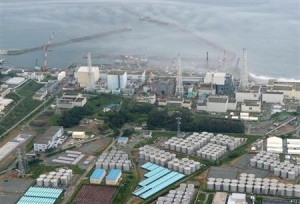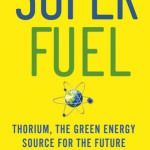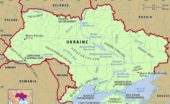Re Ian Bremmer 'Could third-party candidates upend the 2024 US election?' 3 April The current political movement in the USA…
Nuclear energy 2011-2013
Written by Diana Thebaud Nicholson // June 6, 2019 // Cleo Paskal, Nuclear // 3 Comments
International Atomic Energy Agency(IAEA)
Nuclear Energy Institute
World Nuclear Association
SciDevNet Climate Change & Energy: Nuclear power after Fukushima
Wade Allison: The Energy Revolution Must Be Nuclear
If the world is going to get the energy revolution it requires, it needs realistic energy policies that are scientifically sound and promote a fuel that provides plentiful energy on demand, while doing the least harm to nature. That fuel is nuclear.
2013
20 September
 Two years on: How nuclear sells itself post-Fukushima
Two years on: How nuclear sells itself post-Fukushima
(Planet Ark) Two years after catastrophe at Japan’s Fukushima plant, sellers of atomic reactors woo potential buyers with the promise that lessons learned from one of the world’s worst nuclear disasters make the technology safer than ever.
The March 2011 earthquake and tsunami triggered meltdowns and radiation leaks at the plant, 150 miles northeast of Tokyo, causing widespread contamination and prompting mass evacuations.
The shockwave through the nuclear industry has not subsided and Fukushima plant owner Tepco is still struggling to contain the consequences. Last month the firm said new spots of high radiation had been found near storage tanks holding highly contaminated water, raising fear of fresh leaks. …
In the aftermath of the accident many reactor developers reviewed their designs following government guidance and engaged in deep soul-searching that continues more than two years later.
10 July
Japan may restart reactors in a year; Fukushima situation worsens
(Planet Ark) Japan may restart several reactors shut down by the Fukushima nuclear crisis in about a year, a senior regulator said in an interview on Tuesday, a day after new safety rules went into effect designed to avoid a repeat of the disaster.
At the Fukushima Daiichi nuclear plant north of Tokyo, the site of the world’s worst atomic disaster since Chernobyl in 1986, the situation took a turn for the worse as radiation levels in groundwater soared, suggesting highly toxic materials from the plant are now close to the Pacific Ocean.
But Japan is forging ahead with attempts to restart idled reactors in the face of a skeptical public, after Fukushima highlighted weak oversight of the industry.
27 June
 Thorium, the Super Fuel (first broadcast 15 September 2012)
Thorium, the Super Fuel (first broadcast 15 September 2012)
(Quirks & Quarks) especially since last year’s disaster at the Fukushima plant in Japan, support for building new nuclear reactors has fallen. Now, in his new book, SuperFuel: Thorium, the Green Energy Source for the Future, writer Richard Martin makes the case that what we need is a new type of reactor, using a different radioactive material than uranium. And that material is thorium. He argues that using thorium in a Liquid Fluoride Thorium Reactor would be greener, safer, cheaper and more efficient than our standard uranium-based reactors. And the material can’t be used for nuclear weapons. He predicts that thorium-based reactors will take off in the coming decade in places like China and India, while North America remains tied to its nuclear past.
6 January
Work restarts on China’s biggest nuclear power plant: Xinhua
(Planet Ark) Work on China’s largest planned nuclear facility has restarted, state media said on Saturday, a sign that the thaw in the country’s nuclear industry is gaining pace after it was frozen in response to Japan’s Fukushima atomic crisis in 2011.
Building of the Shidao Bay nuclear plant in coastal Shandong province, eastern China, resumed on December 21, Xinhua news agency reported. Beijing – in common with many governments worldwide – suspended work on nuclear projects after the Japanese earthquake and tsunami in March 2011.
2012
28 December
Gentilly-2 cesse de produire de l’électricité
La centrale Gentilly-2, exploitée depuis 1983 à Bécancour, dans le Centre-du-Québec, a cessé de produire de l’électricité vendredi.
Le gouvernement Marois avait annoncé sa fermeture définitive et son déclassement quelques jours après les élections du 4 septembre dernier.
Malgré la contestation et les manifestations, la décision a été maintenue: pour le gouvernement Marois, la réfection de Gentilly-2 ne serait pas économiquement rentable pour les Québécois.
16 December
Japanese operator in most frank admission over nuclear disaster
(Planet Ark/WEN) The operator of a Japanese nuclear power plant that blew up after a tsunami last year said on Friday its lack of safety and bad habits were behind the world’s worst nuclear accident in 25 years, its most forthright admission of culpability.
The operator, Tokyo Electric Power Co, said it accepted the findings of a parliamentary inquiry into the Fukushima nuclear disaster that accused the company of “collusion” with industry regulators.
An earthquake on March 11 last year generated a tsunami that smashed into the nuclear plant on Japan’s northeast coast and triggered equipment failures that led to meltdowns and the spewing of large amounts of radiation into the air and sea.
Takefumi Anegawa, the head of a company reform task force, told a news conference the report by a parliamentary committee contained “so many descriptions about the lack of a safety culture and our bad habits”.
“We admit, we completely admit, that part of the parliamentary report,” Anegawa, told a news conference at the Foreign Correspondents Club of Japan.
1 July
(Nick’s Gleanings) Right now there is an incipient global nuclear power station building boom, with over 60 in the pipeline in 14 countries, 25 of them in China alone. In 1989 Three Mile Island & Chernobyl put paid to the last such boom (that had lasted four decades) & since then their number had grown by just 1.2% to 442 (in 31 countries). While nuclear power plants’ useful life for depreciation purposes is 30-40 years, for practical purposes (that can, however, be, & has often been, extended (limited only by the state of the nuclear reactor vessel). Still, it is a fair assumption that the vast majority of existing nuclear power plants is well into their second ‘half life’ (there are also 240 ‘research reactors’ in 56 countries, 92 of them in developing ones, & 180 reactors in ships).
Given Japan’s Fukushima earthquake cum tsunami event 15 months ago, it may be relevant to note that according to: the Silver Springs,Md.-based NOAA (the National Oceanic and Atmospheric Administration), a US Department of Commerce agency, Japan experienced 180 earthquakes between 684 & 2011 earthquakes with Richter readings of 7.0 or more, of which number 74 were in the 20th century & 18 more since 2000 – while one might question the credibility of the records for the first 1216 years, it nevertheless suggests rather strongly that the rate of serious earthquake incidence in Japan is on the upswing;
and
the New York City-based National Resource Defense Council, of the 442 currently operating nuclear power plants in the world, 12 are in the worst “Very High Hazard” zones in earthquake & tsunami risk terms, six each in Japan & Taiwan (all those in the latter country) while another 36 are rated “High Hazard”, 29 in Japan, four in the US, and one each in Armenia, Iran & Slovenia [given Beijing’s traditional disregard for such minor inconveniences – many of its power dams (incl. the biggest of them all, the not all that well-built Three Gorges Dam) are in high risk earthquake zones – one wonders how these numbers might changed once its nuclear power plant building boom starts to bear fruit.
15 March
George Monbiot: No Primrose Path
To suggest phasing out nuclear power when the world is faced with a climate change crisis is utter madness. It shows that some people have lost sight of which goal is the more important.
… It is not a question of nuclear or renewables or efficiency. To prevent very dangerous levels of climate change, we will need all three.
1 March
What Future Does Nuclear Power Have in Japan?
(Spiegel) Almost a year after the Fukushima disaster, 52 of Japan’s 54 nuclear power plants have been shut down. The reactor explosion destroyed the population’s trust in nuclear energy. But the atomic lobby — and the country’s industrial needs — could block a possible phase-out.
2011
Think Again: Nuclear Power
Japan melted down, but that doesn’t mean the end of the atomic age.
(Foreign Policy Magazine November 2011)) Japan, in fact, was the only formerly pro-nuclear country to experience a change of heart after the accident. The United States is reviewing its safety procedures for nuclear power, but not changing course on it; overall support for the energy source among Americans has hovered around 50 percent since the early 1990s. In France, which gets 78 percent of its electricity from nuclear power, President Nicolas Sarkozy said shutting down reactors was “out of the question.” And as for China, India, and South Korea — countries with a growing appetite for nuclear power that account for the bulk of active plant construction — only the first has put any of its nuclear plans on pause, and that’s just pending a safety review. India and South Korea have vowed to tighten safety standards, but have otherwise forged ahead with plans for nuclear expansion.
28 September
Atomic Dogs
Why can’t the world’s nuclear energy watchdog do anything about Fukushima or Iran’s weapons program?
(Foreign Policy) The story of the IAEA is a story of good intentions getting tangled in officiousness. It is a place where the dominant culture prevents smart people from taking risks. Its mandate is limited by law, but also by an attitude that revels in these limitations.
19 September
Siemens to Exit Nuclear Energy Business
(Spiegel) Siemens plans to pull out of the nuclear energy business, CEO Peter Löscher told SPIEGEL. After the Fukushima nuclear disaster … the company will expand its renewable energy activities instead. “The chapter is closed for us,” Löscher said. “We will no longer be involved in managing the building or financing of nuclear plants.” He attributed the decision to the nuclear disaster at Fukushima in Japan and to the German public’s fear of nuclear energy. He said the company was responding to “German society and politics’ clear position on ending nuclear energy.”
IAEA plan would broaden inspections of nuclear reactors
Forty-four of the world’s 440 nuclear reactors would be inspected for safety over a three-year period as part of a draft proposal by the International Atomic Energy Agency to prevent accidents such as that at the Fukushima Daiichi nuclear plant in Japan. The plan would fortify the IAEA’s status in nuclear-regulatory and reactor standards worldwide even while preserving key roles for national atomic-energy safety agencies. Reuters (8/15)
19 July
During Hillary Clinton’s India visit, nuclear power is front and center
(CSM) With Secretary of State Clinton in India this week, the US and India are attempting to make up for decades of estrangement. However, disagreements about a 2005 nuclear deal threaten progress.
17 July
CP: India courting Canada for nuclear joint venture
(RCI) The Canadian Press news agency is reporting that India is looking for Canadian partners to sell nuclear reactors in new markets, like Africa. The effort comes in the wake of a landmark agreement signed between India and Canada last year on civilian nuclear cooperation. Once it’s ratified by Parliament, the deal will allow the export of Canadian uranium to India. The Canadian Nuclear Association says Indian officials and business executives have been visiting Canada in a search of partnerships. (Toronto Star)
4 July
George Monbiot: Corporate Power? No Thanks
Power corrupts; nuclear power corrupts absolutely. The industry developed as a by-product of nuclear weapons research. Its deployment was used to shield the production of weapons from public view. Though the two industries have now been forced apart, in most parts of the world the nuclear operators remain secretive, unaccountable and far too close to government. … Nuclear operators worldwide have been repeatedly exposed as a bunch of arm-twisting, corner-cutting scumbags.
In this respect they are, of course, distinguished from the rest of the energy industry, which is run by collectives of self-abnegating monks whose only purpose is to spread a little happiness. How they ended up sharing the names and addresses of some of the nuclear companies is a mystery that defies explanation. The front-page story in Friday’s Guardian quoted “former government environmental adviser” Tom Burke saying the following about the government’s relationship with the nuclear companies. “They are too close to industry, concealing problems, rather than revealing and dealing with them.”(3) What the article did not tell us is that Burke currently works for Rio Tinto, one of the world’s biggest coal-mining corporations(4). It has, of course, always refrained from colluding with governments.
All the big energy companies – whether they invest in coal, oil, gas, nuclear, wind or solar power – manipulate politicians, bully regulators and bamboozle the public. Their overweening power causes many kinds of harm; among them is the damage it has done to the case for nuclear technology. Strip away the interests and the arguments are strong.
1 July
The Nuclear Debate
New carbon targets requires reducing emissions of greenhouse gases by 50% for 2030. This house believes that it will be impossible to meet the emissions reductions required to fulfill these obligations without the use of nuclear power.
Taking the pro-nuclear viewpoint are George Monbiot, a freelance journalist, and Malcolm Grimston, a Senior Research Fellow from the Centre for Environmental Policy at Imperial College London.
Arguing against the motion are Doug Parr, Chief Scientist at Greenpeace, and Roger Levett, an independent energy consultant. Presiding over the debate is Karl Rose, Director of Policies and Scenarios at the World Energy Council. [Update The motion was carried 63 – 9. You can watch the debate here. It starts at around 6 minutes 30 seconds in.
29 June
Business as Usual for Atomic Energy at the IAEA
(Spiegel) Since the nuclear disaster at Fukushima, a majority of people across the world have become skeptical of atomic energy. But politicians and experts who recently gathered for an International Atomic Energy Agency conference in Vienna are pursuing a strategy of business as usual.
Yukiya Amano, director general of the International Atomic Energy Agency (IAEA), said that many things needed improvement, including regulatory agencies, disaster prevention and information policy. He called for mandatory IAEA inspections at power plants worldwide, and he proposed that one-tenth of the world’s 440 reactors be selected at random for unannounced inspections over the new three years. In addition, Amano said, plant operators should be held more accountable in the case of future accidents. “Business as usual is not an option,” Amano told the delegates sitting in their United Nations-blue seats.
Following the triple meltdown in Japan, the relevant cabinet ministers of many countries are indeed trying to move on to a business-as-usual agenda as quietly as possible. They seem uninterested in the fact that the majority of mankind now opposes nuclear energy. According to a poll conducted by the Ipsos public opinion research institute, only in India, Poland and the United States does a majority of the public still support nuclear power.
IAEA mulls safety measures as Fukushima efforts stall
International Atomic Energy Agency member states are in broad agreement on the need for increased international safety checks on nuclear power plants in the wake of the Fukushima Daiichi disaster, says Yukiya Amano, head of the IAEA. Member states met for talks this week, and Amano will present an action plan in September. High-tech machines brought in by the operators of the Fukushima plant to reach areas unsafe for humans malfunctioned Friday, delaying efforts to cool damaged reactors. Reuters (6/24), Google/The Associated Press (6/24)
IAEA seeks greater nuclear safety powers
The head of the International Atomic Energy Agency, still reeling from criticism over its handling of Japan’s ongoing nuclear crisis, has proposed a surprisingly far-reaching plan to expand the organization’s role in the enforcement of safety measures. Yukiya Amano, who wants the agency to be empowered to carry out random inspections of nuclear power plants, called upon countries with nuclear reactors to perform risk assessments of their plants within the next year and a half. The Wall Street Journal (tiered subscription model) (6/21), BBC (6/20)
Beginning of the end for nuclear power in Japan?
(CSM) Problems in stabilizing the Fukushima Daiichi nuclear power plant have hardened attitudes: More than 80 percent of Japanese now say they are antinuclear and distrust government information on radiation.
The ongoing crisis at the Fukushima Daiichi nuclear power plant may spell the end of nuclear power in resource-poor Japan, as citizen opposition grows and local authorities refuse permission to restart reactors that have undergone safety checks.
17 June
Nuclear power struggling in post-Fukushima world
(BNN) A number of countries have shelved their nuclear power in the wake of the nuclear meltdown in Japan.
But Glenna Carr, Chair of the Board of Directors of Atomic Ltd. [AECL], tells BNN the industry is already on the mend – and that many countries will struggle to replace nuclear energy with low-carbon emitting power.
6 June
Fukushima aftermath: G20 to discuss nuclear safety
(BBC) G20 energy ministers are set to meet in Paris to discuss nuclear safety in the wake Japan’s Fukushima disaster.
30 May
Germany wants nuclear exit by 2022 at latest
(Reuters) – Germany will shut all its nuclear reactors by 2022 and plans to cut power use by 10 percent by 2020, Chancellor Angela Merkel’s coalition agreed on Monday in a policy u-turn drawn up in a rush after the Fukushima disaster
George Monbiot: I challenge Jonathon Porritt to explain his contention that nuclear power and renewables are incompatible.
(The Guardian) I know that others don’t share my puzzlement, but I don’t understand why the nuclear question needs to divide the environment movement. Our underlying aim is the same: we all want to reduce human impacts on the biosphere. We all agree that our consumption of resources must be reduced, as sharply as possible. We all question the model of endless economic growth. Read more
26 April
Ukraine marks Chernobyl anniversary, eyes Fukushima
(Reuters) – Russian President Dmitry Medvedev on Tuesday called on the world community to tighten safety rules at nuclear plants and tell the truth when there were accidents like those at Chernobyl and Fukushima.
Last week the world community, spurred by the nuclear crisis in Japan, pledged 550 million euros ($780 million) to help build a new containment shell over the stricken reactor at the Chernobyl site to replace a makeshift one that has begun to leak radiation.
UN’s Ban calls for “global re-think” on nuclear energy
UN Secretary-General Ban Ki-moon on Tuesday called for a top-to-bottom review of regulations governing nuclear safety, adding that independent oversight at plants worldwide could retrench public confidence after the disasters at the Chernobyl and Fukushima plants. “How can we ensure the peaceful use of nuclear energy and maximum safety? We need a global re-think on this fundamental question,” he said. Reuters (4/19)
13 April
Bjørn Lomborg: No Nukes?
(Project Syndicate) The harsh reality highlighted by the Fukushima nuclear disaster – is that we do not yet have the luxury of dumping nuclear power. Until we can find a feasible alternative, doing so would mean greater reliance on fossil fuels, and thus higher carbon emissions and more fatalities than nuclear energy has ever caused.
11 April
Analysis: “Peak Everything” May Mute Fukushima Backlash
(Reuters/Planet Ark) Political support may be holding for nuclear power and offshore oil, despite the Fukushima and Macondo disasters, as decision-makers confront climate change and dwindling domestic energy reserves.
A theory of “Peak Everything” suggests we are running short of vital assets such as clean water, carbon-free air, some minerals, fish stocks or the cheap fossil fuels which have powered the world economy and helped curb the price of food.
If you want to secure domestic supplies and curb carbon emissions too, then energy options are limited. And that fact has clearly dawned on governments.
Government’s doomed £6bn plan to dispose of nuclear waste
(The Independent) One month after the Japanese tsunami, the world’s biggest reserve of plutonium waste is reaching crisis point. It was meant to be reprocessed and sold – but now no nation will take it. So where is this vast stockpile? Not Fukushima, but Sellafield, Cumbria
Japanese nervousness about nuclear power following the near-meltdown at the Fukushima plant has led to a freeze in the international trade of reprocessed nuclear fuel that the Government sees as critical to solving Britain’s own plutonium problem.
1 April
Nuclear Power: Can Six Million Frenchmen Be Wrong?
(PBS Frontline) That’s roughly how many French had toured their country’s 58 nuclear plants at the time we aired this report. In fact, over the decades it’s become a popular outing, filled with kids, families and friends. So VIEW here an intriguing little clip on why those French really like nuclear! As usual, a bunch of unique cultural characteristics go into explaining their longtime trust in this technology.
IAEA calls summit as Japan nuclear fears grow
Contaminated water is leaking from a damaged reactor at the Fukushima nuclear plant and may make its way into the ocean, Japanese authorities warn. The International Atomic Energy Agency has called an international summit in June to address fears on nuclear safety around the globe. The New York Times (tiered subscription model) (3/28), AlertNet/Reuters (3/28)
25 March
How dangerous is nuclear power? Not very
Coal, oil and even solar power all kill more people than the much maligned nuclear power.
(The New Statesman) According to research produced here, for every terrawatt of energy produced coal kills 161 people. Oil costs 36 lives for the same amount of energy. Nuclear, however, causes only 0.04 deaths per terrawatt produced. To put it another way, for every person who dies as a result of nuclear power, 4,000 people die due to coal.
Nuclear Moratorium ‘Overly Hasty’
Helmut Kohl Weighs in on Reactor Debate
(Spiegel) Helmut Kohl, who as chancellor oversaw the opening of several nuclear power plants in Germany, has criticized Chancellor Angela Merkel’s course reversal on atomic energy. He warns the government’s decision to retreat on nuclear energy could “make the world a more dangerous place.”
Closing old atom plants poses safety challenge: IAEA
(Reuters) – The closing of aging nuclear reactors is expected to peak in 2020-30, posing a major challenge in terms of safety and the environment, a draft U.N. atomic agency report says
The report, submitted to member states of the International Atomic Energy Agency (IAEA) shortly before Japan’s nuclear crisis erupted this month, said the global nuclear sector maintained a high level of safety performance in 2010.
Fears grow of reactor breach in Japan
Japanese officials warned that radioactive water found near Reactor No. 3 at the Fukushima Daiichi nuclear plant could indicate that there was a breach in the reactor — which could lead to the release of radiation from the combination of plutonium and uranium. Three workers on Thursday suffered burns after stepping into highly radioactive water while trying to cool the quake-stricken plant. The New York Times (free registration) (3/24), Reuters (3/25)
23 March
After Japan Crisis, What’s Next for U.S. Nuclear Policy, Plants? video
(PBS Newshour) As Japan struggles to bring the damaged Fukushima nuclear reactor under control, new questions are surfacing on where U.S. nuclear development stands. Science correspondent Miles O’Brien reports.
22 March
The dramatic events in Japan have, not surprisingly prompted hasty and might we suggest somewhat hysterical, re-examination of national nuclear energy policies
How Quickly Can Germany Abandon Nuclear Energy?
(Spiegel) The new national energy plan unveiled by the German government last autumn is already obsolete in the wake of the Fukushima disaster. Berlin now faces the challenge of devising a new mix of fossil and renewable energy sources to prevent the worst effects of climate change. But how quickly can Germany dispense with nuclear power and what will the phase-out really cost?
Britain goes cold on new plants in Fukushima’s wake
(The Independent) Japan’s nuclear crisis has stalled the growing support for a UK “nuclear renaissance”, a new poll reveals.
Japan tragedy: time for Europe to scrap nuclear power?
(France24) As Japan’s nuclear tragedy intensifies, governments across Europe are divided over the future of nuclear power. France, the world’s second-largest producer insists that it will continue to rely on nuclear energy to preserve the country’s energy independence.
Nukes: Improve them, but don’t even think of abandoning them
(Globe & Mail) … Japan’s government building codes, safety regulations, early-warning systems, shelter networks and safety-training regimes have saved tens of thousands of lives or more. … But what has stopped all of us in our tracks, and seemingly changed many opinions, is not the natural disaster but the catastrophic failure of the Fukushima nuclear plant. The exploding, steaming, uncontrolled electrical-generation complex is the image that has shocked the world.
Though it is a far less deadly event than the seismic shock, the ocean flood or, now, the ill-timed blizzard that has struck northern Japan, the drama at the reactor has galvanized us. And instead of turning against nature’s cruelty, we are turning against the technology designed to fend it off.
This comes at exactly the moment when the world needs many more nuclear reactors and other non-carbon-emitting sources of power.
21 March
George Monbiot: Why Fukushima made me stop worrying and love nuclear power
(The Guardian) Japan’s disaster would weigh more heavily if there were less harmful alternatives. Atomic power is part of the mix
Some greens have wildly exaggerated the dangers of radioactive pollution. For a clearer view, look at the graphic published by xkcd.com. It shows that the average total dose from the Three Mile Island disaster for someone living within 10 miles of the plant was one 625th of the maximum yearly amount permitted for US radiation workers. This, in turn, is half of the lowest one-year dose clearly linked to an increased cancer risk, which, in its turn, is one 80th of an invariably fatal exposure. I’m not proposing complacency here. I am proposing perspective.
Nuclear commission orders Canadian reactors to review safety plans
In the wake of the nuclear crisis in Japan, the Canadian Nuclear Safety Commission has ordered all reactor operators to revisit their safety plans and report on potential improvements to be made by April’s end.
Coalition fights Quebec’s nuclear plant
A Quebec coalition of politicians and activists is calling for the permanent closure of the province’s lone nuclear facility in light of the crisis in Japan.
The group says maintaining Quebec’s Gentilly-2 power plant is dangerous, given the disaster at Japan’s Fukushima Daiichi nuclear plant.
Nuclear debate should include hazards of sticking with fossil fuel
(Vancouver Sun) It turns out that for every person expected to die prematurely because of exposure to radiation from the worst nuclear accident in history, 12,741 will die before their time thanks to exposure to fossil fuel emissions.
Put another way, the calculation of premature deaths per terawatt hour of energy production comes to this conclusion: for coal, 161; for oil, 36; for biofuels, 12; for natural gas, four; for nuclear, 0.04.
Let’s by all means have a robust debate about the future of nuclear energy. Let’s hear all the arguments for it and against it. Let’s also keep things in perspective while we do.
20 March
Cleo Paskal: Why We Build Nuclear Power Stations in Earthquake Zones
The nuclear tragedy currently unfolding in Japan started decades ago on a piece of paper. Before any infrastructure project that size is approved, a risk assessment needs to be done. Hazards are identified and a cost/benefit analysis is made about how to approach those risks. … in many key components of our critical infrastructure, long before the first share is issued, the first shovelful of earth is dug, the first brick is laid, the risk is much higher than anyone knows. Or, in some cases it seems, wants to know. If more Fukushimas are to be avoided, we have to start by understanding the real risk of risk. (See also Chatham House: Japan’s Nuclear Crisis: the Risk of Risk Assessments)
16 March
A cloud of nuclear mistrust spreads around the world
Michael McCarthy: After decades of lies, reassurances fall on deaf ears
(The Independent) … perhaps the most alarming thing was that although Naoto Kan, Japan’s Prime Minister, once again appealed for calm, there are many – in Japan and beyond – who are no longer prepared to be reassured.
15 March
Spent reactor fuel opens new risks in Japan crisis
(Reuters) – A fire and blast at the building protecting a massive pool holding spent atomic fuel has taken Japan’s nuclear crisis to a more critical level.
The pools of spent fuel are dangerous for two reasons: they are more easily exposed to the atmosphere because they don’t have the feet-thick containment wall that protects the nuclear core; the building housing the pool has already suffered hydrogen gas explosions and is open to the sky in places.
They also hold far more radioactive elements that could quickly heat up again if water burns off. Experts worry that this could expose the used nuclear fuel and start a fire that would release more radioactivity.
14 March
Lieberman says hold off on new nuclear plants for now
(CNN) — A Senate proponent of nuclear energy called Sunday for a temporary halt in building new nuclear power plants in the United States until the situation in Japan can be examined.
Japan’s Nuclear Crisis: Lessons for the U.S.
While the cataclysm in Japan was a so-called once-in-a-century event, it also revived fears about the safety of nuclear power, which had regained support as an alternative to global dependence on fossil fuels. What are the lessons so far from the Japan disaster for the nuclear plants in the United States? Which plants or type of plants should we be most concerned about? Can reactors be made strong enough to survive a severe earthquake? Read the debate
Nuclear Disaster ‘Will Have Political Impact as Great as 9/11′
(Spiegel) The nuclear accident at Japan’s Fukushima plant following Friday’s earthquake and tsunami has led to anxious questions in Germany about the safety of its own nuclear reactors and is putting the government under intense pressure to rethink its decision to extend plant lifetimes by an average of 12 years. … Chancellor Angela Merkel’s coalition of conservatives and the pro-business Free Democratic Party (FDP) reversed the planned phaseout of 17 nuclear reactors by 2021. She argued that nuclear power was needed as “bridge technology” to ensure the supply of affordable power as Germany converts to renewable energy generation. She plans to increase the share of renewable generation to 80 percent by 2050, from a current level of only 16 percent.
2 February
China Takes Lead in Race for Clean Nuclear Power
(The Energy Report) China has officially announced it will launch a program to develop a thorium-fueled molten-salt nuclear reactor, taking a crucial step toward shifting to nuclear power as a primary energy source.
The project was unveiled at the annual Chinese Academy of Sciences conference in Shanghai last week, and reported in the Wen Hui Bao newspaper.
If the reactor works as planned, China may fulfill a long-delayed dream of clean nuclear energy. The United States could conceivably become dependent on China for next-generation nuclear technology and/or fall dramatically behind in developing green energy.




3 Comments on "Nuclear energy 2011-2013"
“…average total dose from the Three Mile Island disaster for someone …”
Ya know, you can try to make the case that when Bill Gates walks into a bar, everybody in the bar is filthy rich because the average income has skyrocketed. I’m just not buying because this is an example where an average is meaningless.
Likewise, looking at a chart that reports a low value of the ‘average’ radiation release at Three Mile Island is meaningless. Fallout is distributed very irregularly and all that looking at an average does is cover up what really happened.
Read some interviews with people who lived near Three Mile Island at the time of the accident. There are reports of full loss of body hair and pets found dead when owners returned after evacuating. (See Bill Peters: http://www.tmia.com/witness)
Bill Peters’ description sure sounds like over a few days a lethal dose of radiation wafted across his land. Of course, if you average a lethal dose at one location with doses from locations that weren’t downwind, the averaging process makes this disappear.
Before concluding that the official reports on Three Mile Island are to be believed, do some investigation of information available from other sources.
The message of Nobody’s Fuel is that there are serious consequences to not using nuclear power. The problem identified in Business as Usual for Atomic Energy at the IAEA is that people opposing nuclear do not understand these consequences.
H. Douglas Lightfoot
I agree with Douglas. I have grown deeply pessimistic about the global future in the light of the climate warming that is now bound to happen. The IAEA will soldier on, but it will take a decade or more to rebuild public confidence and we are already running out of time. Books are now coming out that look at the ethical issues, above all the inter-generational ones, that arise from our actions, or lack thereof. That is all well and good; but it is rather late to bemoan the consequences of our short-sightedness. Nuclear offered a slim reed of possibility that we might yet succeed in moderating the warming, with Germany and Japan in the forefront of the countries relying more firmly on this CO2-free technology. How fast the situation has deteriorated.
Frank